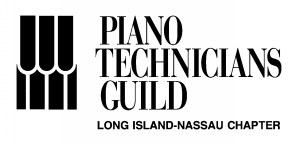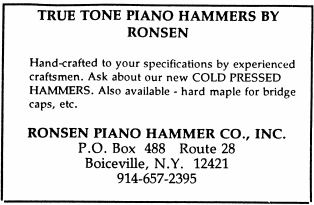
|
Newsletter October, 2011 |
Michael Slavin - President, Paul Eccardt - Vice President, Paul Keogler - Treasurer, Allan Schumacker - Secretary
|
The General Meeting
The general meeting for this month will be held on Tuesday, October 11 starting at 6:30 p.m. at: Frank and Camille's Keyboard Center
371 Old Country Road Carle Place, New York (516) 333-2811 Please note the early starting time of the meeting, to accommodate the extensive nature of the technical presentation. This month's technical class will be by Michael A. Morvan of Blackstone Valley piano, Associate Member, Boston Chapter PTG Mike Morvan has applied machinist skills to the art of key covering and fabrication, and he employs nearly forgotten techniques and procedures once standard in key manufacturing. With his machinist background, state-of-the-art milling machines, and original Pratt & Read keyboard tooling (acquired from Frank Stopa), he provides repair and restoration techniques that incorporate traditional key manufacturing procedures. Located in Massachusetts his company Blackstone Valley Piano (www.pianoandorgankeys.com) continues to offer high quality keyboard and keyframe restoration and fabrication for organ and piano technicians nationwide. Mike has made a leap into the future and added a CNC router. This modern equipment has greatly improved the quality of Mike’s keyboard restoration and fabrication services. It has also enabled Blackstone Valley Piano to provide other much needed services and products to the trade: fabrication of custom buttons, mortise inserts, soundboard cauls, rib shaping cauls, action parts, jigs and fixtures, as well as case parts that supply houses and other manufacturers can’t provide.
Class Description: Keyboard Restoration
The Executive Committee will meet prior to the general meeting at 5 p.m. at the Olive Garden Restaurant, 1120 Old Country Road, Westbury, diagonally across the street from Frank and Camille's. We are happy to report that Bonnie Slavin is beginning to recover from a very serious illness. We wish her the best. |
Tech Tip
by Michael Slavin, Chapter President I was contacted by a piano owner who wanted to have a keytop re-glued. The piano was a 1920s Chickering grand, with the original ivories replaced by cellulose plastic keytops, probably in the '50s. The entire set was still in perfect condition, except for the one unglued keytop, which had curled in both planes --- side-to-side and front-to-back. Although it could have been easily replaced with a new ivorine keytop or a similar one from my collection of old keys, the original would be the ideal choice, both for color-match and fit. I contemplated how to best flatten and restore its shape. Heat seemed a possibility, but a risk --- I wasn't sure if it would become brittle and break, or if it would soften and become pliable. But either way, there was nothing to lose, as it was unusable as is. Before doing anything radical, I placed it in my pin-block support, and using it as a vise, I cranked it down as tight as possible and left it for a few days. (I placed it in between a sheet of folded paper to protect the surface). There was a slight improvement. Next I placed it under a thin, dry washcloth, and weighed it down with a dry iron on medium heat for a few minutes. Upon removal, the keytop was indeed soft and flexible. I quickly placed it back between the folded paper and again into the pin-block "vise," tightened down as much as possible once more. I left it in again for a few days, and at the end of the process, it was perfectly flat and able to be re-glued onto the keystick. 
|